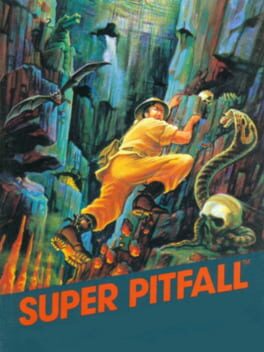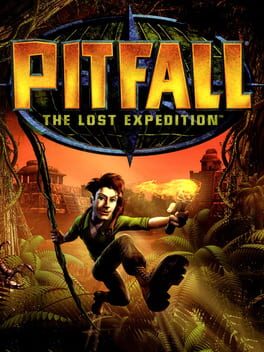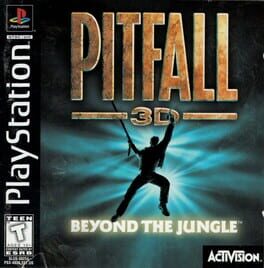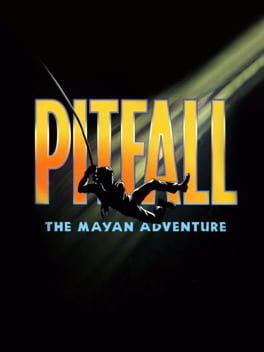Pitfall Harry returns to adventuring in this "Super" sequel to Pitfall! and Pitfall II: Lost Caverns. Harry’s mission: to recover the famed Raj Diamond, and also to rescue his niece Rhonda and loyal lion sidekick, Quickclaw. Now armed with a gun, Harry must navigate some 270 screens of 8-bit action-platforming. Valuable items will be collected along the way to aid your quest, but beware: dangers also abound, from snakes and spiders to falling rocks and boiling lava!
Also in series
Reviews View More
Super Pitfall on the NES is one of the worst games I've ever endured. The controls are beyond frustrating, the level design is pure evil, there's barely any music, and the constant flickering on screen gave me a headache. This is more of a cruel prank in video game form than an actual attempt at fun. Maybe, MAYBE the hardcore masochists out there might get some twisted satisfaction from its insane difficulty, but for the rest of us, it's pure torture.
"Pitfall is one of the best Atari 2600 games; Super Pitfall is one of the worst NES games". ~ Brett Alan Weiss of Allgame
I don't have a ton of reverence towards Pitfall despite perhaps being the 2600's strongest infantryperson, but it's quite damning how much of a fall the series takes in such a short amount of time. Despite being on a system that should be able to solo the Atari 2600 under ten times normal gravity, this alleged remake of Pitfall II is more of a shitpost game that feels like it was meant to be propaganda to dissuade people from buying an NES.
Crouching is fucked just like in the NES port of Ghosts n' Goblins (same dev btw), and despite being able to shoot comically large bullets their hitboxes might as well render them the size of termites, and that's ignoring the fact that most of the rogues gallery are constantly dryhumping the ground rendering them impossible to shoot for your incompetent protagonist who was unable to master the really tricky art of shooting while bending your knees. The game runs like it's getting mauled by a bunch of adware bots, and the stage design may as well have been spat out of a slot machine with progression gated by blindly jump-dancing in pixel-perfect spots in hopes that jiggling the handle will make items appear.
What makes this shit even more funny is that the infamous Famicom kusoge Atlantis no Nazo was originally planned to be localized as the sequel, and I feel like at that point if western audiences had experienced that it would've been like dropping an entire grand piano on the franchise and calling it a day.
Every time I come back to this I get amazed that I can shoot while jumping, like holy shit! I can't believe it! They were at least able to put jumping and shooting in the game! Please clap!
Goddamn I love garbage gaming.
I don't have a ton of reverence towards Pitfall despite perhaps being the 2600's strongest infantryperson, but it's quite damning how much of a fall the series takes in such a short amount of time. Despite being on a system that should be able to solo the Atari 2600 under ten times normal gravity, this alleged remake of Pitfall II is more of a shitpost game that feels like it was meant to be propaganda to dissuade people from buying an NES.
Crouching is fucked just like in the NES port of Ghosts n' Goblins (same dev btw), and despite being able to shoot comically large bullets their hitboxes might as well render them the size of termites, and that's ignoring the fact that most of the rogues gallery are constantly dryhumping the ground rendering them impossible to shoot for your incompetent protagonist who was unable to master the really tricky art of shooting while bending your knees. The game runs like it's getting mauled by a bunch of adware bots, and the stage design may as well have been spat out of a slot machine with progression gated by blindly jump-dancing in pixel-perfect spots in hopes that jiggling the handle will make items appear.
What makes this shit even more funny is that the infamous Famicom kusoge Atlantis no Nazo was originally planned to be localized as the sequel, and I feel like at that point if western audiences had experienced that it would've been like dropping an entire grand piano on the franchise and calling it a day.
Every time I come back to this I get amazed that I can shoot while jumping, like holy shit! I can't believe it! They were at least able to put jumping and shooting in the game! Please clap!
Goddamn I love garbage gaming.
While Super Pitfall was intended as an extension of the formula developed by David Crane with Pitfall II: Lost Caverns (1984), it is perhaps surprising that their critical reception was the polar opposite. Whereas Pitfall II is seen as a flagship of the Atari 2600 for its ambitious platform and exploration gameplay, Super Pitfall is widely regarded by the general public as one of the worst titles on the NES. This difference in opinion can be explained by the difference in technical limitations, which make certain features of the gameplay far less excusable for an NES title, but also by comparison with other games, which elevated players' expectations.
The player controls Harry, who has gone on an expedition to the Andes Mountains, both to save his lion Quickclaw and his niece Rhonda, but also to find the Raj diamond – leaving aside the cultural contradiction, which only seems to illustrate the orientalism of the Western creators. Unlike Pitfall II, where the final objective is visible from the very first screens, Super Pitfall places the player at the top of a gargantuan level, with no indication. Only by starting to explore can the player begin to get their bearings. This beginning is not unlike Metroid (1986), but a critical difference is that the first chamber of the latter is closed. In practice, there is only one way forward: find the Morph Ball on the left, before progressing eastwards and exploring the rest of Brinstar. Super Pitfall does not respect this progressive widening of the scope of exploration. Instead, it is possible to go to the caves on the right or to dive to the depths, without any hints as to what the objectives are.
The main map of Super Pitfall is divided into four sections, which are particularly artificial. Unfortunately, exploration is not unrestricted, as some roads are blocked by doors that the player can only open if they have the associated keys. Such keys are scattered throughout the caverns, but they are invisible and may only be revealed by jumping erratically near them. This highly random and cryptic approach is not unique to the 1980s exploration video game, but it makes it feel cruel and impossible to progress without a guide. When one is perused, it appears that exploration is simply a matter of meandering through the guts in a very specific order, while revealing all the important items. In reality, Super Pitfall is particularly linear and exploration would be almost boring, if the location of objects were openly communicated by the game.
Indeed, beyond its cryptic nature, Super Pitfall has a rather execrable control system, even for NES standards. Harry feels either too heavy or too floaty; collisions are generally poor and the game handles ladders and crouching very badly. While it is possible to shoot enemies, it does not allow to attack ground-crawling foes, making progression frustratingly slow at times. The redirection of jumps in the air is erratic, so that sequences with vines are always awkward. Other more minor issues punctuate the title and worsen the archaic nature of the exploration.
This is a shame, because the structure of Super Pitfall could have resulted, in theory, in a decent game. Secret passages are never properly communicated - one must either jump on birds that look like the standard enemies or jump to a specific location without any indication - yet it leads to visually different sections. The Dark World where Rhonda is imprisoned has the true trappings of a final level, with much more powerful enemies: the atmosphere is quite different with huts perched on huge trees growing inside a cave. In the middle of this section, a sort of massive temple adorned with improbable skulls serves as a prison for the hero's niece. It's a memorable passage, within a generally bland game, and it's unfortunate that the overwhelming majority of players never reached this mystical place, due to the cryptic nature of the game design.
It's hard to find qualities in Super Pitfall, as the execution is so poor. Even with the best will and arming oneself with paper to draw a map – in the pure tradition of early Western games – the title remains stodgy. It's worth noting that in 2016, for the game's thirtieth anniversary, Nesrocks released an extensive romhack that addressed the game's plethoric flaws. The result is far from an exceptional game, but it is certainly much more accessible to the general public. This is probably what Super Pitfall should have been.
The player controls Harry, who has gone on an expedition to the Andes Mountains, both to save his lion Quickclaw and his niece Rhonda, but also to find the Raj diamond – leaving aside the cultural contradiction, which only seems to illustrate the orientalism of the Western creators. Unlike Pitfall II, where the final objective is visible from the very first screens, Super Pitfall places the player at the top of a gargantuan level, with no indication. Only by starting to explore can the player begin to get their bearings. This beginning is not unlike Metroid (1986), but a critical difference is that the first chamber of the latter is closed. In practice, there is only one way forward: find the Morph Ball on the left, before progressing eastwards and exploring the rest of Brinstar. Super Pitfall does not respect this progressive widening of the scope of exploration. Instead, it is possible to go to the caves on the right or to dive to the depths, without any hints as to what the objectives are.
The main map of Super Pitfall is divided into four sections, which are particularly artificial. Unfortunately, exploration is not unrestricted, as some roads are blocked by doors that the player can only open if they have the associated keys. Such keys are scattered throughout the caverns, but they are invisible and may only be revealed by jumping erratically near them. This highly random and cryptic approach is not unique to the 1980s exploration video game, but it makes it feel cruel and impossible to progress without a guide. When one is perused, it appears that exploration is simply a matter of meandering through the guts in a very specific order, while revealing all the important items. In reality, Super Pitfall is particularly linear and exploration would be almost boring, if the location of objects were openly communicated by the game.
Indeed, beyond its cryptic nature, Super Pitfall has a rather execrable control system, even for NES standards. Harry feels either too heavy or too floaty; collisions are generally poor and the game handles ladders and crouching very badly. While it is possible to shoot enemies, it does not allow to attack ground-crawling foes, making progression frustratingly slow at times. The redirection of jumps in the air is erratic, so that sequences with vines are always awkward. Other more minor issues punctuate the title and worsen the archaic nature of the exploration.
This is a shame, because the structure of Super Pitfall could have resulted, in theory, in a decent game. Secret passages are never properly communicated - one must either jump on birds that look like the standard enemies or jump to a specific location without any indication - yet it leads to visually different sections. The Dark World where Rhonda is imprisoned has the true trappings of a final level, with much more powerful enemies: the atmosphere is quite different with huts perched on huge trees growing inside a cave. In the middle of this section, a sort of massive temple adorned with improbable skulls serves as a prison for the hero's niece. It's a memorable passage, within a generally bland game, and it's unfortunate that the overwhelming majority of players never reached this mystical place, due to the cryptic nature of the game design.
It's hard to find qualities in Super Pitfall, as the execution is so poor. Even with the best will and arming oneself with paper to draw a map – in the pure tradition of early Western games – the title remains stodgy. It's worth noting that in 2016, for the game's thirtieth anniversary, Nesrocks released an extensive romhack that addressed the game's plethoric flaws. The result is far from an exceptional game, but it is certainly much more accessible to the general public. This is probably what Super Pitfall should have been.





